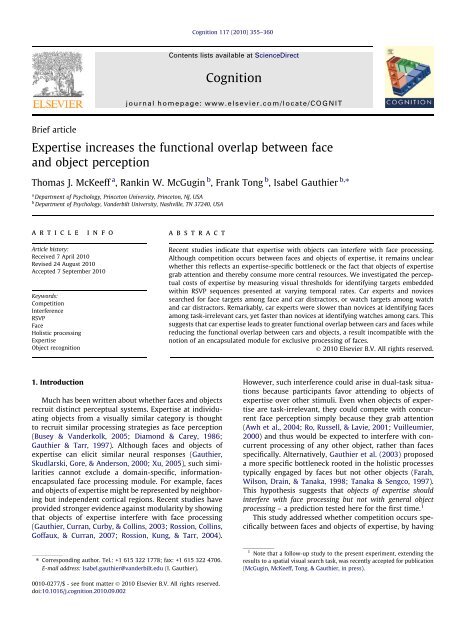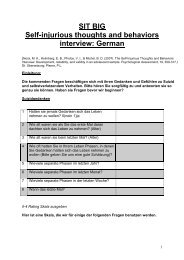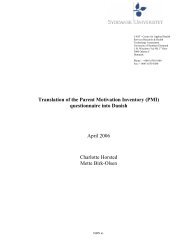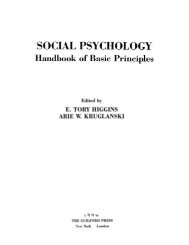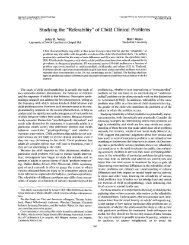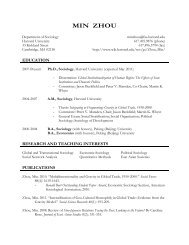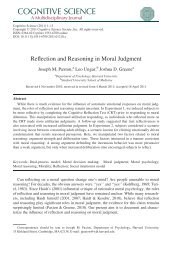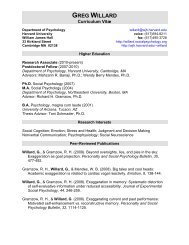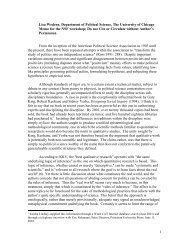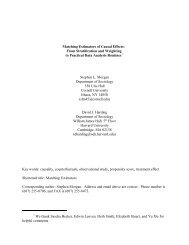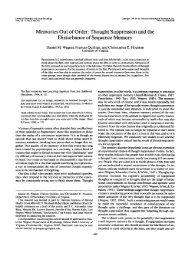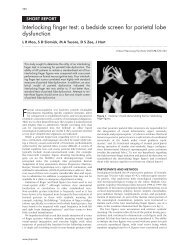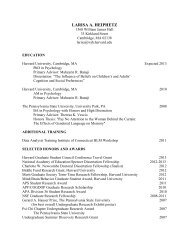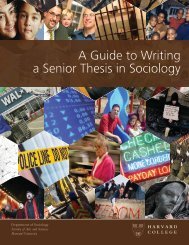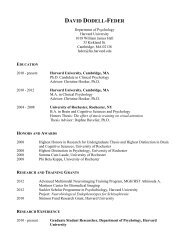Expertise increases the functional overlap between face and object ...
Expertise increases the functional overlap between face and object ...
Expertise increases the functional overlap between face and object ...
Create successful ePaper yourself
Turn your PDF publications into a flip-book with our unique Google optimized e-Paper software.
Brief article<br />
<strong>Expertise</strong> <strong>increases</strong> <strong>the</strong> <strong>functional</strong> <strong>overlap</strong> <strong>between</strong> <strong>face</strong><br />
<strong>and</strong> <strong>object</strong> perception<br />
Thomas J. McKeeff a , Rankin W. McGugin b , Frank Tong b , Isabel Gauthier b,⇑<br />
a Department of Psychology, Princeton University, Princeton, NJ, USA<br />
b Department of Psychology, V<strong>and</strong>erbilt University, Nashville, TN 37240, USA<br />
article info<br />
Article history:<br />
Received 7 April 2010<br />
Revised 24 August 2010<br />
Accepted 7 September 2010<br />
Keywords:<br />
Competition<br />
Interference<br />
RSVP<br />
Face<br />
Holistic processing<br />
<strong>Expertise</strong><br />
Object recognition<br />
1. Introduction<br />
abstract<br />
Much has been written about whe<strong>the</strong>r <strong>face</strong>s <strong>and</strong> <strong>object</strong>s<br />
recruit distinct perceptual systems. <strong>Expertise</strong> at individuating<br />
<strong>object</strong>s from a visually similar category is thought<br />
to recruit similar processing strategies as <strong>face</strong> perception<br />
(Busey & V<strong>and</strong>erkolk, 2005; Diamond & Carey, 1986;<br />
Gauthier & Tarr, 1997). Although <strong>face</strong>s <strong>and</strong> <strong>object</strong>s of<br />
expertise can elicit similar neural responses (Gauthier,<br />
Skudlarski, Gore, & Anderson, 2000; Xu, 2005), such similarities<br />
cannot exclude a domain-specific, informationencapsulated<br />
<strong>face</strong> processing module. For example, <strong>face</strong>s<br />
<strong>and</strong> <strong>object</strong>s of expertise might be represented by neighboring<br />
but independent cortical regions. Recent studies have<br />
provided stronger evidence against modularity by showing<br />
that <strong>object</strong>s of expertise interfere with <strong>face</strong> processing<br />
(Gauthier, Curran, Curby, & Collins, 2003; Rossion, Collins,<br />
Goffaux, & Curran, 2007; Rossion, Kung, & Tarr, 2004).<br />
⇑ Corresponding author. Tel.: +1 615 322 1778; fax: +1 615 322 4706.<br />
E-mail address: Isabel.gauthier@v<strong>and</strong>erbilt.edu (I. Gauthier).<br />
0010-0277/$ - see front matter Ó 2010 Elsevier B.V. All rights reserved.<br />
doi:10.1016/j.cognition.2010.09.002<br />
Cognition 117 (2010) 355–360<br />
Contents lists available at ScienceDirect<br />
Cognition<br />
journal homepage: www.elsevier.com/locate/COGNIT<br />
Recent studies indicate that expertise with <strong>object</strong>s can interfere with <strong>face</strong> processing.<br />
Although competition occurs <strong>between</strong> <strong>face</strong>s <strong>and</strong> <strong>object</strong>s of expertise, it remains unclear<br />
whe<strong>the</strong>r this reflects an expertise-specific bottleneck or <strong>the</strong> fact that <strong>object</strong>s of expertise<br />
grab attention <strong>and</strong> <strong>the</strong>reby consume more central resources. We investigated <strong>the</strong> perceptual<br />
costs of expertise by measuring visual thresholds for identifying targets embedded<br />
within RSVP sequences presented at varying temporal rates. Car experts <strong>and</strong> novices<br />
searched for <strong>face</strong> targets among <strong>face</strong> <strong>and</strong> car distractors, or watch targets among watch<br />
<strong>and</strong> car distractors. Remarkably, car experts were slower than novices at identifying <strong>face</strong>s<br />
among task-irrelevant cars, yet faster than novices at identifying watches among cars. This<br />
suggests that car expertise leads to greater <strong>functional</strong> <strong>overlap</strong> <strong>between</strong> cars <strong>and</strong> <strong>face</strong>s while<br />
reducing <strong>the</strong> <strong>functional</strong> <strong>overlap</strong> <strong>between</strong> cars <strong>and</strong> <strong>object</strong>s, a result incompatible with <strong>the</strong><br />
notion of an encapsulated module for exclusive processing of <strong>face</strong>s.<br />
Ó 2010 Elsevier B.V. All rights reserved.<br />
However, such interference could arise in dual-task situations<br />
because participants favor attending to <strong>object</strong>s of<br />
expertise over o<strong>the</strong>r stimuli. Even when <strong>object</strong>s of expertise<br />
are task-irrelevant, <strong>the</strong>y could compete with concurrent<br />
<strong>face</strong> perception simply because <strong>the</strong>y grab attention<br />
(Awh et al., 2004; Ro, Russell, & Lavie, 2001; Vuilleumier,<br />
2000) <strong>and</strong> thus would be expected to interfere with concurrent<br />
processing of any o<strong>the</strong>r <strong>object</strong>, ra<strong>the</strong>r than <strong>face</strong>s<br />
specifically. Alternatively, Gauthier et al. (2003) proposed<br />
a more specific bottleneck rooted in <strong>the</strong> holistic processes<br />
typically engaged by <strong>face</strong>s but not o<strong>the</strong>r <strong>object</strong>s (Farah,<br />
Wilson, Drain, & Tanaka, 1998; Tanaka & Sengco, 1997).<br />
This hypo<strong>the</strong>sis suggests that <strong>object</strong>s of expertise should<br />
interfere with <strong>face</strong> processing but not with general <strong>object</strong><br />
processing – a prediction tested here for <strong>the</strong> first time. 1<br />
This study addressed whe<strong>the</strong>r competition occurs specifically<br />
<strong>between</strong> <strong>face</strong>s <strong>and</strong> <strong>object</strong>s of expertise, by having<br />
1 Note that a follow-up study to <strong>the</strong> present experiment, extending <strong>the</strong><br />
results to a spatial visual search task, was recently accepted for publication<br />
(McGugin, McKeeff, Tong, & Gauthier, in press).
356 T.J. McKeeff et al. / Cognition 117 (2010) 355–360<br />
car experts <strong>and</strong> novices search for <strong>face</strong> targets of a particular<br />
identity among <strong>face</strong> <strong>and</strong> car distractors, or watch targets<br />
among watch <strong>and</strong> car distractors. We predicted that<br />
car experts would be selectively impaired at distinguishing<br />
<strong>face</strong>s in <strong>the</strong> presence of task-irrelevant cars, but as good as<br />
or better than novices at distinguishing o<strong>the</strong>r <strong>object</strong>s (e.g.,<br />
watches) in <strong>the</strong> presence of car distractors. Items were<br />
shown at varying temporal rates using rapid serial visual<br />
presentation (RSVP) to determine presentation rate thresholds<br />
for target identification. Thus, we targeted perceptual<br />
processes that can be maintained at rapid presentation<br />
rates (McKeeff, Remus, & Tong, 2007; Potter & Levy, 1969).<br />
We reasoned that if perceptual thresholds were systematically<br />
affected by expertise for task-irrelevant items, <strong>the</strong>n<br />
this would provide strong evidence of perceptual competition<br />
<strong>between</strong> <strong>face</strong>s <strong>and</strong> <strong>object</strong>s of expertise.<br />
2. Method<br />
2.1. Participants<br />
Eleven car experts (mean age 25 years, 2 females) <strong>and</strong><br />
eleven car novices (mean age 26 years, 3 females) participated,<br />
all right-h<strong>and</strong>ed with normal or corrected-to-normal<br />
visual acuity. The study was approved by <strong>the</strong> V<strong>and</strong>erbilt<br />
University Institutional Review Board. All participants provided<br />
written informed consent.<br />
2.2. Stimuli <strong>and</strong> design<br />
Participants performed a two-alternative forced-choice<br />
discrimination task, which required discriminating which<br />
of two possible targets appeared within each RSVP sequence.<br />
Presentation rate was adjusted adaptively on each<br />
trial to estimate <strong>the</strong> threshold rate at which participants<br />
could discriminate <strong>the</strong> target identity at 82% accuracy,<br />
with faster temporal thresholds indicating superior discrimination<br />
performance. There were four conditions: <strong>face</strong><br />
targets with <strong>face</strong> <strong>and</strong> car distractors (F/FC), <strong>face</strong> targets<br />
with <strong>face</strong> <strong>and</strong> watch distractors (F/FW), watch targets with<br />
watch <strong>and</strong> <strong>face</strong> distractors (W/WF) <strong>and</strong> watch targets with<br />
watch <strong>and</strong> car distractors (W/WC). It was important to include<br />
distractors from both <strong>the</strong> target category <strong>and</strong> competing<br />
category for this experimental design. The<br />
inclusion of distractors from <strong>the</strong> target category minimized<br />
<strong>the</strong> likelihood that participants could rely on low-level<br />
cues to detect <strong>the</strong> target item, while <strong>the</strong> inclusion of distractor<br />
items from <strong>the</strong> second category allowed us to assess<br />
<strong>the</strong> degree to which <strong>the</strong>y interfered with processing<br />
of <strong>the</strong> items from <strong>the</strong> target category. Stimuli included<br />
grayscale images of 30 <strong>face</strong>s, 30 cars, <strong>and</strong> 30 watches<br />
(15.5° 15.5° of visual angle). To avoid salient diagnostic<br />
features, we removed hair from <strong>face</strong>s <strong>and</strong> text from<br />
watches. Images were presented on a 21-in., CRT monitor<br />
(refresh rate, 75 Hz) with a Macintosh G3 computer using<br />
Matlab <strong>and</strong> Psychtoolbox.<br />
Participants completed 30 practice trials for each of <strong>the</strong><br />
four target-distractor conditions, followed by 16 experimental<br />
blocks (four of each condition) with 30 trials in<br />
each block. Block order was counterbalanced across sub-<br />
jects. Each block began with a pair of r<strong>and</strong>omly selected<br />
<strong>face</strong> targets (or watch targets), which participants could<br />
study for as long as needed. Each trial began with a fixation<br />
cross for 4000 ms, followed by an RSVP sequence of 20<br />
images alternating <strong>between</strong> <strong>the</strong> two distractor categories.<br />
Images were presented successively at <strong>the</strong> same central<br />
location, with no interstimulus interval. For each sequence,<br />
a r<strong>and</strong>omization procedure was used to determine <strong>the</strong> sequence<br />
of distractor images to be shown, <strong>the</strong> serial position<br />
of <strong>the</strong> target (anywhere but <strong>the</strong> first or last<br />
positions) <strong>and</strong> which of <strong>the</strong> two targets would appear at<br />
that position. After each sequence, participants indicated<br />
which target appeared by pressing one of two keys. Within<br />
each block, <strong>the</strong> presentation rate started at 7.075 items/s,<br />
<strong>and</strong> was varied subsequently using an adaptive staircase<br />
procedure to converge at 82% discrimination accuracy<br />
(Watson & Pelli, 1983). Thresholds for each participant<br />
<strong>and</strong> condition were based on <strong>the</strong> average of estimates over<br />
<strong>the</strong> four blocks.<br />
Car expertise was quantified using a sequential matching<br />
task in which participants matched car images at<br />
<strong>the</strong> level of model, regardless of year (Gauthier, Curby,<br />
Skudlarski, & Epstein, 2005; Gauthier et al., 2000; Rossion<br />
et al., 2004; Xu, 2005). The same task, involving bird<br />
images of different species, provided a baseline for motivation<br />
<strong>and</strong> general perceptual skill. Participants performed<br />
112 trials in each task. Results yielded sensitivity (d 0 )<br />
scores for cars <strong>and</strong> for birds. A Car <strong>Expertise</strong> index was defined<br />
as <strong>the</strong> difference <strong>between</strong> car <strong>and</strong> bird performance<br />
(Car d 0 – Bird d 0 )(Gauthier et al., 2000a; Gauthier et al.,<br />
2003). We were unable to collect any matching scores from<br />
three novices <strong>and</strong> bird matching scores from two car<br />
experts. None<strong>the</strong>less, excluding <strong>the</strong>se participants led to<br />
no reliable differences in <strong>the</strong> pattern of results.<br />
3. Results<br />
Our performance-based index of car expertise revealed<br />
superior performance by self-reported car experts (Dd 0 =<br />
1.98) relative to novices (Dd 0 = 0.19; F(1, 15) = 84.08,<br />
p < .0001). Self-reported car experts performed better<br />
than novices when matching cars (d 0 = 2.69, SD = 0.54<br />
<strong>and</strong> d 0 = 0.95, SD = 0.61 respectively), (F(1, 17) = 43.10,<br />
p < .0001), but comparably when matching birds (d 0 = 0.77,<br />
SD = 0.43 <strong>and</strong> d 0 = 0.76, SD = 0.22 respectively), (F(1, 15) <<br />
1, n.s.). All self-reported car experts had a Dd 0 greater than<br />
1.4 whereas no novice performed better than 0.7.<br />
In <strong>the</strong> main experiment, we determined <strong>the</strong> threshold<br />
presentation rate at which subjects could still accurately<br />
discriminate which of two <strong>face</strong> targets (or two watch targets)<br />
had appeared among <strong>the</strong> set of distractors for that<br />
experimental condition. Performance for <strong>the</strong> <strong>face</strong> <strong>and</strong><br />
watch searches in <strong>the</strong> presence of various task-irrelevant<br />
distractors was quantified using mean presentation rate<br />
threshold (Fig. 1). Although our visual task differed in difficulty<br />
across experiment conditions (as evidence by variations<br />
in novice performance), of greater relevance was how<br />
expertise led to changes in performance relative to that of<br />
novices, our baseline comparison Group. While car experts<br />
<strong>and</strong> novices obtained similar thresholds when looking for
Fig. 1. Presentation rate thresholds for car novices <strong>and</strong> car experts who<br />
searched for (A) <strong>face</strong> targets among <strong>face</strong> <strong>and</strong> car distractors (F/FC), or <strong>face</strong><br />
targets among <strong>face</strong> <strong>and</strong> watch distractors (F/FW), <strong>and</strong> (B) watch targets<br />
among watch <strong>and</strong> car distractors (W/WC), or watch targets among watch<br />
<strong>and</strong> <strong>face</strong> distractors (W/WF).<br />
<strong>face</strong> targets among watches, car experts were relatively<br />
slower than novices when searching for <strong>face</strong>s among cars<br />
(Fig. 1A). This cannot be attributed to irrelevant cars grabbing<br />
<strong>the</strong> attention of car experts, because experts were faster<br />
than novices at identifying watch targets among<br />
irrelevant cars, while <strong>the</strong> two groups were comparable<br />
when searching for watches among irrelevant <strong>face</strong>s.<br />
These observations were supported by statistical analyses.<br />
The mean threshold for each participant <strong>and</strong> condition<br />
was submitted to a three-way ANOVA with Target (<strong>face</strong> vs.<br />
watch) <strong>and</strong> Distractor Category (car vs. watch/<strong>face</strong>) as<br />
within-subject factors, <strong>and</strong> Group (expert vs. novice) as a<br />
<strong>between</strong>-subject factor. The three-way interaction was significant<br />
(F(1, 20) = 12.06, p < .01) <strong>and</strong> two-way ANOVAs<br />
were performed for each target condition to investigate<br />
this interaction.<br />
With a <strong>face</strong> target, <strong>the</strong>re was a trend for a differential<br />
effect of Distractor Category on performance <strong>between</strong> car<br />
T.J. McKeeff et al. / Cognition 117 (2010) 355–360 357<br />
experts <strong>and</strong> novices (F(1, 20) = 3.69, p = .07), Fig. 1A). Car<br />
experts required slower presentation rates than novices<br />
to identify <strong>face</strong>s among cars (F(1, 20) = 4.17, p < .04). In<br />
contrast, <strong>the</strong>re was no threshold difference <strong>between</strong><br />
groups for <strong>face</strong> targets among watch distractors (p = .62).<br />
It is important to note that absolute search rates are<br />
influenced by category homogeneity (e.g., better search<br />
rate for F/FW than W/WF) <strong>and</strong> that car <strong>and</strong> watch distractor<br />
conditions should not be compared directly because<br />
<strong>face</strong>s may be more visually similar to watches than to car<br />
profiles. More meaningful is <strong>the</strong> relative difficulty of target<br />
conditions as a function of expertise. We performed a<br />
more powerful continuous analysis (Preacher, Rucker,<br />
MacCallum, & Nicew<strong>and</strong>er, 2005) in which an interference<br />
index was defined as <strong>the</strong> difference in threshold for<br />
<strong>the</strong> two irrelevant distractor categories, divided by <strong>the</strong><br />
sum of <strong>the</strong>se thresholds (F/FW F/FC)/(F/FC + F/FW). Car<br />
expertise was directly related to this interference index<br />
(r = .69, p < .001; Fig. 2A). Thus, task-irrelevant car distractors<br />
interfered with <strong>face</strong> perception as a function of<br />
car expertise.<br />
For watch targets, we also observed an interaction <strong>between</strong><br />
Distractor Category (cars vs. <strong>face</strong>s) <strong>and</strong> Group<br />
(F(1, 20) = 6.11, p < .05; Fig. 1B). There was a trend for car experts<br />
to identify watch targets at higher presentation rates<br />
than novices when distractors were cars (F(1, 20) = 2.61,<br />
p = .12). As expected, no difference in threshold was observed<br />
<strong>between</strong> groups when searching for watches among<br />
<strong>face</strong>s (p = .64). Here, <strong>the</strong>re was a significant negative correlation<br />
<strong>between</strong> interference index [(W/WF W/WC)/(W/<br />
WC + W/WF)] <strong>and</strong> car expertise index (r = .55, p < .02;<br />
Fig. 2B). Task-irrelevant cars interfered with watch perception<br />
as a function of car expertise, but in this case expertise<br />
makes it easier to ignore task-irrelevant cars.<br />
4. Discussion<br />
The present study provides novel evidence that expertise<br />
can alter perceptual thresholds systematically <strong>and</strong> that<br />
competition <strong>between</strong> <strong>face</strong>s <strong>and</strong> <strong>object</strong>s of expertise has a<br />
Fig. 2. Correlation <strong>between</strong> car expertise index <strong>and</strong> (A) an index of interference <strong>between</strong> <strong>face</strong>s <strong>and</strong> cars [(F/FW F/FC)/(F/FC + F/FW)] or (B) an index of<br />
interference <strong>between</strong> cars <strong>and</strong> watches [(W/WF W/WC)/(W/WC + W/WF)].
358 T.J. McKeeff et al. / Cognition 117 (2010) 355–360<br />
category-specific, ra<strong>the</strong>r than central, locus. Specifically,<br />
car experts required more time than novices to find <strong>face</strong>s<br />
among cars, yet required less time than novices to discriminate<br />
watches among car distractors. This crossover interaction<br />
<strong>between</strong> expertise <strong>and</strong> target-type rules out many<br />
accounts. Competition <strong>between</strong> <strong>face</strong>s <strong>and</strong> <strong>object</strong>s of expertise<br />
does not arise simply because expertise leads to obligatory<br />
capture of attention or depletion of central resources<br />
(Awh et al., 2004; Ro et al., 2001; Vuilleumier, 2000),<br />
o<strong>the</strong>rwise car distractors should have interfered with experts’<br />
watch discrimination. Moreover, familiarity or<br />
expertise does not merely result in more efficient processing<br />
of distractors (Mruczek & Sheinberg, 2005; Tong &<br />
Nakayama, 1999; Wang, Cavanagh, & Green, 1994), since<br />
cars were easier for car experts to ignore only when<br />
searching for <strong>object</strong>s, not for <strong>face</strong>s. Ra<strong>the</strong>r, our results suggest<br />
that <strong>the</strong> presence of car distractors raises or lowers<br />
perceptual thresholds in experts depending on <strong>the</strong> perceptual<br />
strategy required to discriminate <strong>the</strong> target category.<br />
When car experts rely on holistic processing to search for<br />
<strong>face</strong>s (Farah et al., 1998), this strategy, well suited for expert<br />
car perception, leads to interference from car distractors.<br />
However, when <strong>the</strong> same expert searches for a watch,<br />
she uses part-based processing, making cars easier to<br />
ignore. It has been suggested that <strong>face</strong> processing does<br />
not depend on general capacity limits, but on <strong>face</strong>-specific<br />
capacity limits (Lavie, Ro, & Russell, 2003) – our results<br />
suggest that <strong>the</strong>se limits are better described as processspecific.<br />
The results suggest that perceptual competition was an<br />
important contributor in previous studies of interference<br />
<strong>between</strong> <strong>face</strong>s <strong>and</strong> <strong>object</strong>s. EEG studies have reported that<br />
<strong>the</strong> N170 <strong>face</strong>-selective potential (Bentin, McCarthy, Perez,<br />
Puce, & Allison, 1996; Rossion et al., 2000) is attenuated<br />
when <strong>face</strong>s are presented concurrently with <strong>object</strong>s of<br />
expertise (Rossion et al., 2004, 2007). This could result<br />
from direct perceptual competition or from decreased<br />
attention to <strong>face</strong>s in <strong>the</strong> presence of o<strong>the</strong>r interesting <strong>object</strong>s.<br />
Ano<strong>the</strong>r study found that holistic <strong>face</strong> processing is<br />
impaired when car experts maintain cars in working memory<br />
(Gauthier et al., 2003). Again, this might be attributed<br />
to competition <strong>between</strong> <strong>the</strong> visual representations resulting<br />
from immediate perception <strong>and</strong> those maintained in<br />
working memory, or to how experts allocate central resources<br />
to each task. A recent study suggests that <strong>the</strong><br />
source of this competition does not have its locus in working<br />
memory (Cheung & Gauthier, 2010). The crossover<br />
interaction found in <strong>the</strong> present study indicates that <strong>the</strong><br />
competition <strong>between</strong> <strong>face</strong>s <strong>and</strong> <strong>object</strong>s of expertise is relatively<br />
peripheral, <strong>and</strong> likely perceptual in nature. If taskirrelevant<br />
cars depleted only central attentional resources,<br />
<strong>the</strong>n experts should have shown impairments in both <strong>face</strong><br />
<strong>and</strong> <strong>object</strong> processing, ra<strong>the</strong>r than a benefit in <strong>object</strong><br />
processing.<br />
While <strong>the</strong> idea that experts process non-<strong>face</strong> <strong>object</strong>s<br />
holistically has been controversial (McKone, Kanwisher, &<br />
Duchaine, 2007), recent work suggests that experience<br />
individuating non-<strong>face</strong> <strong>object</strong>s can produce this hallmark<br />
of <strong>face</strong> processing (Wong, Palmeri, & Gauthier, 2009).<br />
Therefore, <strong>the</strong> notion that expertise leads to greater holistic<br />
processing remains <strong>the</strong> best c<strong>and</strong>idate to account for<br />
<strong>the</strong> similarity of <strong>face</strong> <strong>and</strong> car processing in car experts<br />
(Gauthier et al., 2003). Although we believe <strong>the</strong> source of<br />
<strong>the</strong> competition observed here has a perceptual locus, we<br />
acknowledge that <strong>the</strong> locus of holistic processing itself<br />
(perceptual vs. decisional) remains debated (Mack, Richler,<br />
Gauthier, & Palmeri, in press; Richler, Gauthier, Wenger, &<br />
Palmeri, 2008; Wenger & Ingvalson, 2002).<br />
While it is intriguing to ask whe<strong>the</strong>r <strong>face</strong> distractors<br />
would selectively impact car identification by car experts,<br />
multiple factors could affect performance when expertise<br />
for targets is manipulated <strong>and</strong> <strong>the</strong> results would be more<br />
difficult to interpret. For instance, car processing should<br />
be less perceptually taxing (<strong>and</strong> more motivating) for car<br />
experts than novices, potentially allowing attentional resources<br />
to spill over to irrelevant items regardless of category<br />
(Lavie, 1995).<br />
The fact that expertise with an <strong>object</strong> category leads to<br />
both greater perceptual competition with <strong>face</strong> processing<br />
<strong>and</strong> decreased competition with <strong>object</strong> processing suggests<br />
that <strong>the</strong> acquisition of expertise represents a shift<br />
from one type of strategy (or representation, Dicarlo &<br />
Cox, 2007) in favor of ano<strong>the</strong>r. Our results can be discussed<br />
within a framework proposed by Kinsbourne <strong>and</strong> Hicks<br />
(1978) in which <strong>the</strong> degree of interference <strong>between</strong> any<br />
two processes or representations depends on <strong>the</strong>ir ‘‘cerebral<br />
<strong>functional</strong> distance” (CFD). This framework emphasizes<br />
that <strong>the</strong> brain is a highly linked network in which<br />
activation spreads <strong>and</strong> decays as a function of distance.<br />
An increase in competition <strong>between</strong> two tasks with expertise<br />
reflects a decrease in CFD. An interesting prediction of<br />
<strong>the</strong> CFD framework is that expertise should affect not only<br />
holistic <strong>face</strong> processing but also affect <strong>object</strong> processing in<br />
<strong>the</strong> opposite direction, as was found here.<br />
What changes might be occurring at a neural level to<br />
account for perceptual competition due to expertise? The<br />
nature of neural <strong>object</strong> representations is controversial,<br />
with some proposing that <strong>face</strong> representations are<br />
especially focal (Kanwisher, McDermott, & Chun, 1997;<br />
Spiridon & Kanwisher, 2002; Tsao, Freiwald, Tootell, &<br />
Livingstone, 2006) <strong>and</strong> o<strong>the</strong>rs favoring distributed, <strong>overlap</strong>ping<br />
representations for <strong>face</strong>s <strong>and</strong> <strong>object</strong>s (Haxby<br />
et al., 2001; O’Toole, Jiang, Abdi, & Haxby, 2005). Of relevance<br />
here, <strong>object</strong> representations can be altered by experience.<br />
<strong>Expertise</strong> with <strong>object</strong>s is associated with greater<br />
activation in <strong>and</strong> nearby <strong>face</strong>-selective regions of <strong>the</strong><br />
ventral visual pathway (Gauthier et al., 2000, 2005; Moore,<br />
Cohen, & Ranganath, 2006; Wong, Palmeri, Rogers, Gore, &<br />
Gauthier, 2009; Wong et al., 2009; Xu, 2005) which suggests<br />
greater <strong>overlap</strong> with <strong>the</strong> neural representation of<br />
<strong>face</strong>s. Alternatively, neuronal populations for <strong>face</strong>s <strong>and</strong><br />
trained <strong>object</strong>s could remain separate while inhibitory<br />
connections <strong>between</strong> <strong>the</strong>se networks become more extensive.<br />
According to <strong>the</strong> CFD framework, both <strong>the</strong> degree of<br />
neuronal <strong>overlap</strong> <strong>and</strong> <strong>the</strong> strength of inhibitory connections<br />
could alter <strong>the</strong> effective <strong>functional</strong> distance <strong>between</strong><br />
visual representations. Recent studies have focused primarily<br />
on neural <strong>overlap</strong> <strong>between</strong> <strong>object</strong> representations<br />
(Gauthier et al., 2000; Grill-Spector, Knouf, & Kanwisher,<br />
2004; Tong, Nakayama, Moscovitch, Weinrib, & Kanwisher,<br />
2000; Tsao et al., 2006), <strong>and</strong> though some <strong>overlap</strong> is<br />
typically found, it remains difficult to predict how much
<strong>overlap</strong> would be necessary to translate into perceptual<br />
competition. An advantage of <strong>the</strong> CFD framework is its focus<br />
on <strong>the</strong> <strong>functional</strong> impact of <strong>overlap</strong> <strong>between</strong> processes<br />
or representations. Even if two separate neuronal populations<br />
represent different <strong>object</strong>s, <strong>functional</strong> <strong>overlap</strong> could<br />
still be high due to mutually competitive interactions. In<br />
this case, nei<strong>the</strong>r neuronal population would be ‘‘<strong>functional</strong>ly<br />
encapsulated” <strong>and</strong> <strong>the</strong> performance of one would fail<br />
to operate independently of <strong>the</strong> o<strong>the</strong>r. In that sense,<br />
regardless of <strong>the</strong>ir neural underpinnings, our results are<br />
inconsistent with <strong>the</strong> notion of a domain-specific module<br />
for <strong>face</strong> perception that operates independently from <strong>the</strong><br />
processing of stimuli outside this domain. Future modeling<br />
efforts, combined with neurophysiological recordings, will<br />
be key in unraveling <strong>the</strong> mechanisms underlying competition<br />
effects.<br />
Acknowledgements<br />
This research was supported by <strong>the</strong> Temporal Dynamics<br />
of Learning Center (NSF Science of Learning Center SBE-<br />
0542013), NSF award BCS-0642633 to F.T., NEI award 2<br />
R01 EY013441 to IG <strong>and</strong> grants from <strong>the</strong> V<strong>and</strong>erbilt Vision<br />
Research Center (P30-EY008126) <strong>and</strong> a JSMF award to <strong>the</strong><br />
Perceptual <strong>Expertise</strong> Network. We thank Cindy Bukach,<br />
Kim Curby <strong>and</strong> Ludvik Bukach for help with participant<br />
recruitment <strong>and</strong> data collection.<br />
References<br />
Awh, E., Serences, J., Laurey, P., Dhaliwal, H., van der Jagt, T., & Dassonville,<br />
P. (2004). Evidence against a central bottleneck during <strong>the</strong> attentional<br />
blink: Multiple channels for configural <strong>and</strong> featural processing.<br />
Cognitive Psychology, 48(1), 95–126.<br />
Bentin, S., McCarthy, G., Perez, E., Puce, A., & Allison, T. (1996).<br />
Electrophysiological studies of <strong>face</strong> perception in humans. Journal of<br />
Cognitive Neuroscience, 8, 551–565.<br />
Busey, T. A., & V<strong>and</strong>erkolk, J. R. (2005). Behavioral <strong>and</strong> electrophysiological<br />
evidence for configural processing in fingerprint experts.<br />
Vision Research, 45(4), 431–448.<br />
Cheung, O. S.-C., & Gauthier, I. (2010). Selective interference on <strong>the</strong><br />
holistic processing of <strong>face</strong>s in working memory. Journal of<br />
Experimental Psychology: Human Perception <strong>and</strong> Performance, 36(2),<br />
448–461.<br />
Diamond, R., & Carey, S. (1986). Why <strong>face</strong>s are <strong>and</strong> are not special: An<br />
effect of expertise. Journal of Experimental Psychology: General, 115(2),<br />
107–117.<br />
Dicarlo, J. J., & Cox, D. D. (2007). Untangling invariant <strong>object</strong> recognition.<br />
Trends in Cognitive Sciences, 11(8), 333–341.<br />
Farah, M.-J., Wilson, K.-D., Drain, M., & Tanaka, J.-N. (1998). What is<br />
‘‘special” about <strong>face</strong> perception? Psychological Review, 105(3),<br />
482–498.<br />
Gauthier, I., Curby, K. M., Skudlarski, P., & Epstein, R. A. (2005). Individual<br />
differences in FFA activity suggest independent processing at<br />
different spatial scales. Cognitive <strong>and</strong> Affective Behavioral<br />
Neuroscience, 5(2), 222–234.<br />
Gauthier, I., Curran, T., Curby, K. M., & Collins, D. (2003). Perceptual<br />
interference supports a non-modular account of <strong>face</strong> processing.<br />
Nature Neuroscience, 6(4), 428–432.<br />
Gauthier, I., Skudlarski, P., Gore, J. C., & Anderson, A. W. (2000). <strong>Expertise</strong><br />
for cars <strong>and</strong> birds recruits brain areas involved in <strong>face</strong> recognition.<br />
Nature Neuroscience, 3(2), 191–197.<br />
Gauthier, I., & Tarr, M. J. (1997). Becoming a ‘‘greeble” expert: Exploring<br />
mechanisms for <strong>face</strong> recognition. Vision Research, 37(12), 1673–1682.<br />
Grill-Spector, K., Knouf, N., & Kanwisher, N. (2004). The fusiform <strong>face</strong> area<br />
subserves <strong>face</strong> perception, not generic within-category identification.<br />
Nature Neuroscience, 7(5), 555–562.<br />
Haxby, J. V., Gobbini, M. I., Furey, M. L., Ishai, A., Schouten, J. L., & Pietrini,<br />
P. (2001). Distributed <strong>and</strong> <strong>overlap</strong>ping representations of <strong>face</strong>s <strong>and</strong><br />
<strong>object</strong>s in ventral temporal cortex. Science, 293(5539), 2425–2430.<br />
T.J. McKeeff et al. / Cognition 117 (2010) 355–360 359<br />
Kanwisher, N., McDermott, J., & Chun, M. M. (1997). The fusiform <strong>face</strong><br />
area: A module in human extrastriate cortex specialized for <strong>face</strong><br />
perception. Journal of Neuroscience, 17(11), 4302–4311.<br />
Kinsbourne, M., & Hicks, R. E. (1978). Functional cerebral space: A model<br />
for overflow, transfer <strong>and</strong> interference effects in human performance.<br />
In J. Requin (Ed.), Attention <strong>and</strong> performance (pp. 345–362). New York:<br />
Academic Press.<br />
Lavie, N. (1995). Perceptual load as a necessary condition for selective<br />
attention. Journal of Experimental Psychology: Human Perception <strong>and</strong><br />
Performance, 21(3), 451–468.<br />
Lavie, N., Ro, T., & Russell, C. (2003). The role of perceptual load in<br />
processing distractor <strong>face</strong>s. Psychological Science, 14(5), 510–515.<br />
Mack, M. L., Richler, J. J., Gauthier, I., & Palmeri, T. J. (in press). Indecision<br />
on decisional separability. Psychonomic Bulletin & Review.<br />
McGugin, R. W., McKeeff, T. J., Tong, F., Gauthier, I. (in press). Irrelevant<br />
<strong>object</strong>s of expertise compete with <strong>face</strong>s during visual search.<br />
Attention, Perception & Psychophysics.<br />
McKeeff, T. J., Remus, D. A., & Tong, F. (2007). Temporal limitations in<br />
<strong>object</strong> processing across <strong>the</strong> human ventral visual pathway. Journal of<br />
Neurophysiology, 98, 382–393.<br />
McKone, E., Kanwisher, N., & Duchaine, B. (2007). Can generic expertise<br />
explain special processing for <strong>face</strong>s? Trends in Cognitive Sciences,<br />
11(1), 8–15.<br />
Moore, C. D., Cohen, M. X., & Ranganath, C. (2006). Neural mechanisms of<br />
expert skills in visual working memory. Journal of Neuroscience,<br />
26(43), 11187–11196.<br />
Mruczek, R. E., & Sheinberg, D. L. (2005). Distractor familiarity leads to<br />
more efficient visual search for complex stimuli. Perception &<br />
Psychophysics, 67(6), 1016–1031.<br />
O’Toole, A. J., Jiang, F., Abdi, H., & Haxby, J. V. (2005). Partially distributed<br />
representations of <strong>object</strong>s <strong>and</strong> <strong>face</strong>s in ventral temporal cortex.<br />
Journal of Cognitive Neuroscience, 17(4), 580–590.<br />
Potter, M. C., & Levy, E. I. (1969). Recognition memory for a rapid<br />
sequence of pictures. Journal of Experimental Psychology, 81(1),<br />
10–15.<br />
Preacher, K. J., Rucker, D. D., MacCallum, R. C., & Nicew<strong>and</strong>er, W. A. (2005).<br />
Use of <strong>the</strong> extreme groups approach: A critical reexamination <strong>and</strong><br />
new recommendations. Psychological Methods, 10, 178–192.<br />
Richler, J. J., Gauthier, I., Wenger, M. J., & Palmeri, T. J. (2008). Holistic<br />
processing of <strong>face</strong>s: Perceptual <strong>and</strong> decisional components. Journal of<br />
Experimental Psychology: Learning, Memory <strong>and</strong> Cognition, 34(2),<br />
328–342.<br />
Ro, T., Russell, C., & Lavie, N. (2001). Changing <strong>face</strong>s: A detection<br />
advantage in <strong>the</strong> flicker paradigm. Psychological Science, 12(1),<br />
94–99.<br />
Rossion, B., Collins, D., Goffaux, V., & Curran, T. (2007). Long-term<br />
expertise with artificial <strong>object</strong>s <strong>increases</strong> visual competition with<br />
early <strong>face</strong> categorization processes. Journal of Cognitive Neuroscience,<br />
19(3), 543–555.<br />
Rossion, B., Gauthier, I., Tarr, M., Despl<strong>and</strong>, P.-A., Linotte, S., Bruyer, R.,<br />
et al. (2000). The n170 occipito-temporal component is enhanced <strong>and</strong><br />
delayed to inverted <strong>face</strong>s but not to inverted <strong>object</strong>s: An<br />
electrophysiological account of <strong>face</strong>-specific processes in <strong>the</strong> human<br />
brain. NeuroReport, 11, 1–6.<br />
Rossion, B., Kung, C. C., & Tarr, M. J. (2004). Visual expertise with non<strong>face</strong><br />
<strong>object</strong>s leads to competition with <strong>the</strong> early perceptual processing of<br />
<strong>face</strong>s in <strong>the</strong> human occipitotemporal cortex. Proceedings of <strong>the</strong><br />
National Academy of Sciences of <strong>the</strong> United States of America, 101(40),<br />
14521–14526.<br />
Spiridon, M., & Kanwisher, N. (2002). How distributed is visual category<br />
information in human occipito-temporal cortex? An fmri study.<br />
Neuron, 35(6), 1157–1165.<br />
Tanaka, J. W., & Sengco, J. A. (1997). Features <strong>and</strong> <strong>the</strong>ir configuration in<br />
<strong>face</strong> recognition. Memory & Cognition, 25(5), 583–592.<br />
Tong, F., & Nakayama, K. (1999). Robust representations for <strong>face</strong>s:<br />
Evidence from visual search. Journal of Experimental Psychology:<br />
Human Perception <strong>and</strong> Performance, 25(4), 1016–1035.<br />
Tong, F., Nakayama, K., Moscovitch, M., Weinrib, O., & Kanwisher, N.<br />
(2000). Response properties of <strong>the</strong> human fusiform <strong>face</strong> area.<br />
Cognitive Neuropsychology, 17, 257–279.<br />
Tsao, D. Y., Freiwald, W. A., Tootell, R. B., & Livingstone, M. S. (2006). A<br />
cortical region consisting entirely of <strong>face</strong>-selective cells. Science,<br />
311(5761), 670–674.<br />
Vuilleumier, P. (2000). Faces call for attention: Evidence from patients<br />
with visual extinction. Neuropsychologia, 38(5), 693–700.<br />
Wang, Q., Cavanagh, P., & Green, M. (1994). Familiarity <strong>and</strong> pop-out in<br />
visual search. Perception & Psychophysics, 56(5), 495–500.<br />
Watson, A. B., & Pelli, D. G. (1983). Quest: A bayesian adaptive<br />
psychometric method. Perception & Psychophysics, 33(2), 113–120.
360 T.J. McKeeff et al. / Cognition 117 (2010) 355–360<br />
Wenger, M. J., & Ingvalson, E. M. (2002). A decisional component of<br />
holistic encoding. Journal of Experimental Psychology: Learning,<br />
Memory, <strong>and</strong> Cognition, 28(5), 872–892.<br />
Wong, A. C.-N., Palmeri, T. J., & Gauthier, I. (2009). Conditions for <strong>face</strong>like<br />
experties with <strong>object</strong>s: Becoming a Ziggerin expert – But which type?<br />
Psychological Science, 20(9), 1108–1117.<br />
Wong, A. C.-N., Palmeri, T. J., Rogers, B. P., Gore, J. C., & Gauthier, I. (2009).<br />
Beyond shape: How you learn about <strong>object</strong>s affects how <strong>the</strong>y are<br />
represented in visual cortex. PLoS One, 4(12), e8405.<br />
Xu, Y. (2005). Revisiting <strong>the</strong> role of <strong>the</strong> fusiform <strong>face</strong> area in visual<br />
expertise. Cerebral Cortex, 15(8), 1234–1242.


